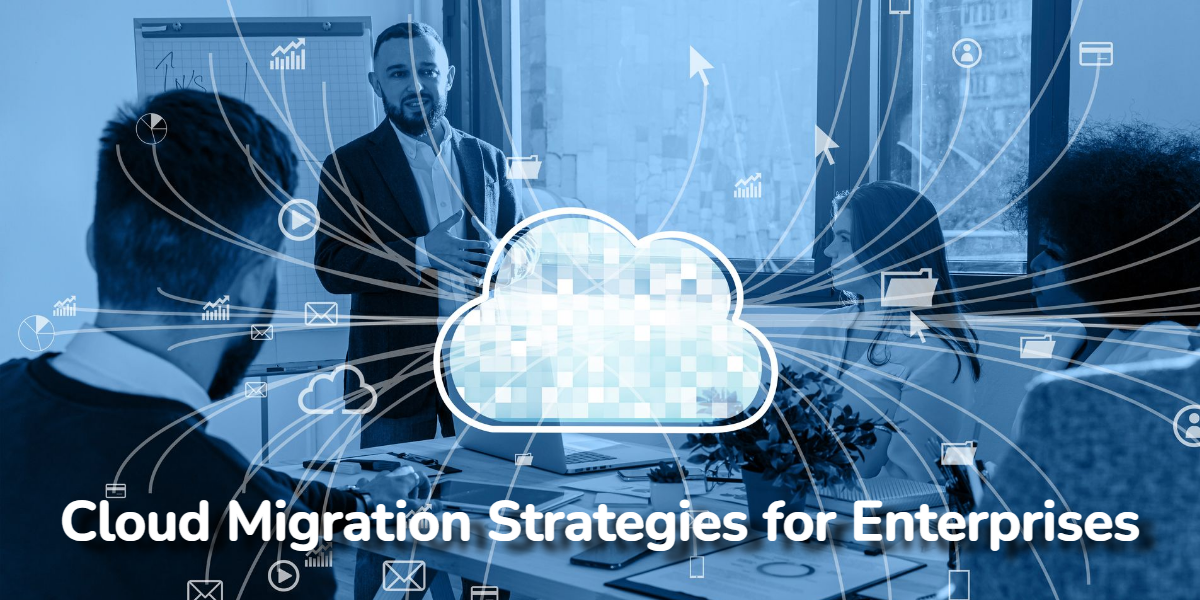Cloud Migration Strategies for Enterprises: A Complete Guide

Cloud migration is the process of transferring your organization’s data, applications, and/or services to the cloud. It has become a necessary step for many companies that see the opportunity to improve productivity and thus save money.
In this blog, we will discuss various approaches to cloud migration for organizations based on a set of guidelines.
Understanding Cloud Migration
What is Cloud Migration?
Cloud migration means the transfer of an organization’s data onto a cloud service provider’s platform. These can be public, shared resources, private with resources for one organization, or hybrid, a mixture of the two.
Cost Efficiency:
Cloud migration highly minimizes various costs related to on-premises hardware. These namely servers and storage devices, together with maintenance and energy costs. In terms of affordability, the cloud mainly has a usage-based cost structure. It makes the service possible without the need for a large initial investment. It does not tie any large amounts in the long term as the conventional IT infrastructure does.
Scalability:
One of the major strengths of cloud migration is the ability to bring in more and better resources. This means that businesses that need more resources during specific periods. Or those that need to cut costs due to lower demand. It can up and downscale resources such as computation, storage, and bandwidth without having to worry about hardware purchases and installations.
Accessibility:
Cloud solutions allow an employee or business access to his or her applications or data. No matter where they are located as long as they have an internet connection. This interactive availability away from headquarters fosters more flexibility in the work that is done. It is mainly how it is done, and where it is done, beneficial interconnection of cross-region teams. Also, more importantly, it ensures the availability of critical information when required.
Disaster Recovery:
Cloud migration enhances this notion since it provides disaster recovery models with better data backup and recovery solutions. When disaster or data loss occurs, cloud providers normally have many data centers and backup techniques. Hence, they are still better off than on-premise data centers.
Security:
Garnering support of cloud providers, there are usually security mechanisms and compliance solutions that can be considered to safeguard the information and applications. Some of these features include encryption, access controls, and automatic security updates by IT professionals. These are some of the advantages of using cloud services. Since they could provide a higher level of security than most businesses could afford or maintain for themselves.
Performance:
When implemented, cloud computing can enable organizations to achieve better efficiency in application. They do better performance due to the higher standards of infrastructure and technologies offered by cloud providers than local ones. Cloud solutions sometimes employ the newest and most powerful hardware. Also, distributing the resources, which contributes to higher application and service performance.
Innovation:
Migration helps Leverage modern and updated technologies. These are usually available on the cloud, such as subscription-based services. This improves business innovation. With cloud services, it is easy for organizations to adopt and implement such technologies. So, such examples are artificial intelligence, machine learning, and big data analytics, before making a huge capital investment in hardware or software.
Key Cloud Migration Strategies
.png)
Rehosting (Lift and Shift)
Rehosting signifies the complete relocation of applications and data to the cloud while making relatively slight changes. It is very simple and efficient, though it seldom utilizes most of the cloud's characteristics. Use this if you need to make the move and go for the big fields.
Replatforming
Replatforming, therefore, entails a few modifications to the applications in order to function well in a cloud environment. It can be considered as the middle ground between re-platforming and complete application redesign. This approach is useful if you want to fine-tune the processes as opposed to doing a major redesign.
Refactoring (Re-architecting)
Refactoring implies redesigning of applications from the ground up to maximize the exploitation of Cloud opportunities. This can be a rather intricate and lengthy process. Although, at the same time, it provides the highest levels of performance and server capacity. Use this if you need to renovate your applications, or in other words, update or make them look more modern.
Repurchasing
Repurchasing can be described as buying your current applications over, possibly in the cloud, such as SaaS or Software as a Service. This is usually employed for basic use, for instance, in cases where one is just utilizing emails or managing customers.
Retiring
Retiring entails leaving something or making changes that remove something considered useless from the way it was being used. This can help to shave costs and simplify the general organizational structure. Determine which system retains the old and worn out and which can be scrapped completely.
Retaining
A hybrid is the concept of consolidating some systems in the local network while migrating others to the cloud. It might be needed for applications where cloud interfaces do not function optimally. Yet, they have to work effectively in the cloud environment.
Planning Your Cloud Migration
Assessing Your Current IT Environment:
Infrastructural analysis should be the first step in identifying the current IT provisions and requirements. Record all the application data as well as the manner in which the data is used. This activity will assist you in defining how broad or narrow the migration is going to be, and what exactly has to be migrated and how.
Defining Goals and Objectives:
Ensure that the goals of your migration are clearly outlined for you to achieve or meet your overall business objectives. This might encompass such areas as scaling, cost, or even performance rates in an organization. Set standards for assessing the results of the migration to ensure the tracking of the migration process and its results is done as required.
Choosing the Right Cloud Model:
Different cloud deployment models include; public, private, and hybrid cloud service models, and they should be chosen based on an organization’s requirements. Consider cloud service providers’ cost, features, compliance, and support services to recommend the most appropriate choice for your organization.
Developing a Migration Plan:
Develop a migration plan. In the case of multi-step migration, develop a clear migration plan. Next, choose between mass upload, meaning transferring all files within a single step. These also include gradual migration, and moving files in stages, which can help avoid common pitfalls and tweak the process. It is important to see that the plan has a time frame, resources needed, and who will do the work.
Risk Management and Compliance:
Determine possible threats that can be incurred when migrating and the steps to be taken to avoid them, including loss of data or insecurity. Ascertain that the migration process meets all the legal requirements necessary to perform the migration to avoid legal or operational problems regarding the changes.
Implementation and Execution
Migration Planning and Building a Migration Team
Organize yourself to gather a group of experts who will be able to address various parts of the migration. This team should comprise IT specialists, project managers, and employees of the relevant organizational departments since all requirements and challenges are likely to come from different areas of the company.
Data Migration and Integration
Create a comprehensive plan used for the migration of data to the cloud while ensuring data consistency. Integrated policies to reduce time wastage such as avoiding migrating data during certain times of the day and tools for migration.
Application Migration
It is essential to introduce the migrations of the applications to the cloud environment gradually. It is also important to conduct testing on applications post-migration to check on their functionality and solve any problems. These are noticed so as to optimize the running of applications.
Change Management
Ensure your team does not struggle when transitioning to AWS systems by providing them with AWS training and useful materials to work with. Management should, therefore, effectively communicate with the support staff. They have to ensure they change and embrace the new cloud environment where necessary, providing them with solutions to problems they encounter.
Post-Migration Considerations
Monitoring and Optimization
When organizations decide to move to cloud services, it is important to conduct regular audits to determine how well or poorly the cloud services are performing. Maintain monitoring mechanisms to look at the resource consumption rates, work, and possible problems. These services should be fine-tuned to configure the cost and effectiveness by allocating the resources or scaling up or down the services. Or it may be using the native Cloud features such that one is not paying a lot or the resources are not wasted.
Continuous Improvement
Make it a best practice to check from time to time or conduct an evaluation of your cloud infrastructure and plans for improvement. Discover new technologies and additional features that can make the service perform better, cost less, or offer additional functionality. Such a method allows continued and competitive operations to adopt innovations and improve the operations of the clouds.
Security and Compliance Re-evaluation
From time to time check up on your security postures and ensure that you comply with the set rules and regulations. Thus, it means that no matter how the cloud environments and the security threats develop, your security should remain strong and effective. Periodically review the current state of your cloud environment. It helps to ensure it follows contemporary best practices and legal requisites and then applies changes that ensure security and compliance.
Conclusion
Cloud migration can prove highly advantageous for your business through aspects. These are cost efficiency, flexibility, and the enhancement of business capacity for performance. It is, therefore, very important to follow the following steps when migrating: selecting the right migration strategy. It also includes planning for the migration process and managing the migration process. If you haven’t begun migrating your applications today, do so now or hire a professional to help you out.
Hyperlink InfoSystem - Most Trusted End-to-End development Solution Provider.
Write For Us





